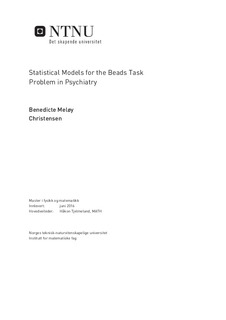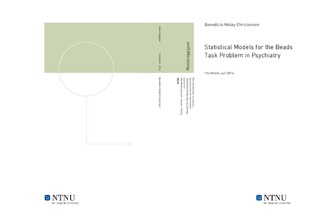| dc.contributor.advisor | Tjelmeland, Håkon | |
| dc.contributor.author | Christensen, Benedicte Meløy | |
| dc.date.accessioned | 2016-10-04T14:01:00Z | |
| dc.date.available | 2016-10-04T14:01:00Z | |
| dc.date.created | 2016-06-17 | |
| dc.date.issued | 2016 | |
| dc.identifier | ntnudaim:15089 | |
| dc.identifier.uri | http://hdl.handle.net/11250/2412894 | |
| dc.description.abstract | The tendency to "jump to conclusion" and make decisions on basis of little evidence has been linked with being prone to delusions. This behavior is particularly seen in the "beads task", where participant are presented with a sequence of beads and asked to decide which jar the beads are drawn from. In this thesis, we construct statistical models that explain the observed behavior in the beads task. Our models are based on work previously done by Moutoussis \textit{et al.}. The models in our thesis contain quantifiable parameters that capture the bias towards making hasty decisions and the noise in decision-making. Two of the models also incorporate the noise in subjective probability estimates. We describe how the model parameters can be estimated through Bayesian analysis and perform a simulation study which shows that the parameters can be accurately retained. Finally, we fit the models to a real data set. These models may be utilized to see if there are any group differences between deluded patients and healthy controls. | |
| dc.language | nob | |
| dc.publisher | NTNU | |
| dc.subject | Fysikk og matematikk, Industriell matematikk | |
| dc.title | Statistical Models for the Beads Task Problem in Psychiatry | |
| dc.type | Master thesis | |
| dc.source.pagenumber | 77 | |

